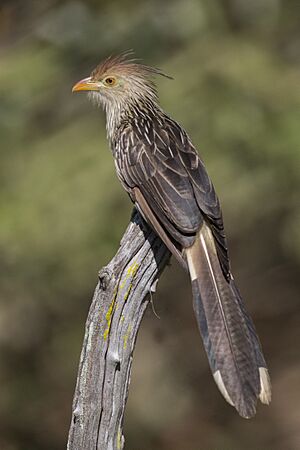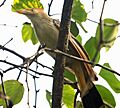Guira cuckoo facts for kids
Quick facts for kids Guira cuckoo |
|
|---|---|
 |
|
| At the Pantanal, Brazil | |
| Conservation status | |
| Scientific classification | |
| Genus: |
Guira
|
| Species: |
guira
|
 |
|
The guira cuckoo (Guira guira) is a cool bird that loves to hang out in groups. You can find these birds in open areas and places with some trees, like in Brazil, Uruguay, Paraguay, Bolivia, and Argentina. It's the only type of bird in its special group, called Guira.
Contents
About the Guira Cuckoo's Name
The guira cuckoo was first written about and drawn in 1648 by a German scientist named Georg Marcgrave. He called it "Guira angatara." The word Güirá actually means "bird" in the Guarani language, which is spoken by some native people in South America.
Later, in 1788, another German scientist named Johann Friedrich Gmelin gave it the scientific name Cuculus guira. This was part of a big book that listed all known animals. Today, the guira cuckoo is the only bird in its own special group, or genus, called Guira. It's a unique bird, and there are no different types (subspecies) of it. It's also closely related to other birds called anis.
What Does the Guira Cuckoo Look Like?
The guira cuckoo is about 34 cm (13 in) (about 13 inches) long, which is roughly the length of a ruler. It weighs around 140 g (4.9 oz) (about 5 ounces), which is like a small apple. Boy and girl guira cuckoos look very much alike, but the female is usually a little bit bigger. Young guira cuckoos look a lot like the adults.
These birds have dark brown feathers on their backs with white stripes. Their throats, chests, bellies, and rumps are a creamy white color. They have a long, wide, dark brown tail with a white tip. Their legs are dark gray. Their eyes and beaks are yellow or orange, and they have a thin ring of yellow skin around their eyes. One of the coolest things about them is their bright orange-red crest of feathers on their heads!
The guira cuckoo has a very special call that you can't miss. It's long and loud, sounding like a whistle or even a wail. Also, like some other cuckoos, the guira cuckoo has a strong, unique smell.
Guira Cuckoo Behavior and Habitat
Guira cuckoos love open spaces like grassy fields and wet areas. They have actually spread to more places because of deforestation, which means more open land. You can often spot them in parks and gardens in towns and cities.
These birds are not the best at flying long distances. They usually fly only for short bursts. You'll often see them gliding or hopping from one branch to another, making their loud calls.
Even though they are mostly tree birds, they often look for food on the ground. They might be alone, but often you'll see them in groups of up to 18 birds! Sometimes, they even hang out with other birds like the smooth-billed ani, who act similarly. Unlike some cuckoos you might have heard about, the guira cuckoo does not lay its eggs in other birds' nests. They build their own nests and raise their own young.
What Guira Cuckoos Eat
The guira cuckoo is a clever hunter and will eat many different things it finds. They look for small animals on the ground or among tree branches. Their diet includes worms, insects, spiders, tadpoles, frogs, and even eggs. They also eat small birds (especially baby birds in nests) and tiny mammals like mice. Sometimes, they even catch and eat lizards!
Guira Cuckoo Reproduction
Guira cuckoos build their nests in the forks of trees, usually about 2 to 5 m (6.6 to 16.4 ft) (6.5 to 16 feet) off the ground. The eggs are dark green and covered with a chalky layer. A female guira cuckoo usually lays between 5 and 7 eggs.
Sometimes, many females will lay their eggs in one big "community nest." In these nests, you can find up to 20 eggs! You might also see many broken eggs under these community nests. This happens because there's a lot of competition among the young birds, and sadly, many don't survive.
Gallery
-
At the National Aviary, Pennsylvania.
-
in the Pantanal, Brazil
-
Scavenging for food at Costanera Sur, Argentina









